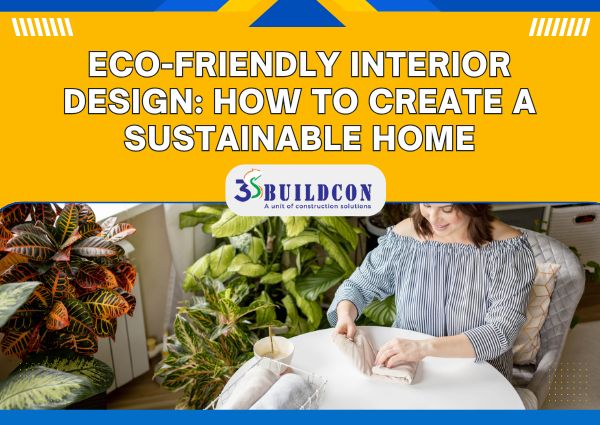Sustainability is now a need rather than merely a fad in today’s globe. With climate change and environmental concerns on the rise, homeowners are seeking ways to make their homes more eco-friendly. At 3S Buildcon, we believe in creating sustainable living spaces that not only reduce environmental impact but also enhance comfort and well-being. This guide will help you transform your home into an eco-friendly sanctuary using innovative interior design solutions.
- Use Sustainable Materials
One of the best ways to make your home eco-friendly is by incorporating sustainable materials into your interior design. Opt for natural, renewable, and non-toxic materials that have a lower carbon footprint. Some excellent choices include:
- Bamboo: A rapidly renewable resource that can be used for flooring, furniture, and decor.
- Reclaimed Wood: Adds warmth and character while reducing the need for new timber.
- Cork: A biodegradable and insulating material perfect for flooring and wall coverings.
- Recycled Metal & Glass: Durable and stylish choices for countertops, lighting fixtures, and furniture.
- Energy-Efficient Lighting
Lighting plays a significant role in interior design and energy consumption. Switching to LED or CFL bulbs can reduce electricity usage by up to 75%. Additionally, consider these energy-efficient lighting strategies:
- Maximize Natural Light: Use large windows, skylights, and glass doors to bring in more daylight.
- Smart Lighting Systems: Install motion sensors and dimmable LED lights to optimize energy use.
- Solar-Powered Lights: A great option for outdoor lighting, reducing reliance on non-renewable energy sources.
- Eco-Friendly Paints and Finishes
Conventional paints and finishes often contain volatile organic compounds (VOCs), which can be harmful to indoor air quality. Instead, choose:
- Low-VOC or Zero-VOC Paints: These paints are safer for health and the environment.
- Natural Finishes: Use clay, lime, or milk-based paints to create a chemical-free home.
- Water-Based Stains and Sealers: Ideal for wooden surfaces, reducing toxic emissions.
- Sustainable Flooring Options
Your flooring choice has a significant impact on sustainability. Consider these eco-friendly alternatives:
- Bamboo Flooring: Durable, stylish, and rapidly renewable.
- Recycled Tiles: Made from repurposed materials such as glass and porcelain.
- Linoleum: Made from natural ingredients like linseed oil and cork, it’s biodegradable and long-lasting.
- Wool or Jute Carpets: Avoid synthetic carpets that release harmful chemicals.
- Indoor Plants for Natural Air Purification
Adding greenery to your home not only enhances aesthetics but also improves indoor air quality. Some excellent air-purifying plants include:
- Aloe Vera: Removes toxins and provides a natural healing element.
- Snake Plant: Absorbs CO2 at night and releases oxygen.
- Peace Lily: Filters harmful pollutants from the air.
- Spider Plant: Low-maintenance and excellent at removing indoor air toxins.
- Water Conservation Techniques
One crucial component of an eco-friendly home is minimizing water waste. Consider these water-saving interior solutions:
- Low-Flow Fixtures: Install showerheads, toilets, and faucets that use less water.
- Rainwater Harvesting: Collect rainwater for household use.
- Greywater Recycling Systems: Reuse wastewater from sinks and showers for irrigation.
- Energy-Efficient Appliances & Smart Home Technology
Your carbon footprint can be significantly decreased by making an investment in energy-efficient appliances. Look for:
- ENERGY STAR-Certified Appliances: These use less electricity and water.
- Smart thermostats: minimize energy waste by optimizing heating and cooling.
- Solar Panels: Generate clean energy and reduce dependency on fossil fuels.
- Upcycled and Recycled Furniture
Instead of buying new furniture, consider upcycling old pieces or purchasing from sustainable brands. Some ideas include:
- Refurbished Wooden Furniture: Adds character and reduces deforestation.
- Recycled Plastic Chairs and Tables: Durable and environmentally friendly.
- Vintage Finds: Give a second life to pre-owned furniture.
- Eco-Conscious Textile Choices
Opt for organic and sustainable textiles when selecting curtains, upholstery, and bedding. Look for:
- Organic Cotton: Free from harmful pesticides.
- Hemp and Linen: Durable and biodegradable fabrics.
- Recycled Polyester: Made from repurposed plastic bottles, reducing waste.
- Minimalist and Sustainable Design Approach
Sustainability and minimalism go hand in hand. Adopting a less-is-more philosophy can help reduce waste and create a clutter-free, energy-efficient home:
- Choose Multi-Functional Furniture: Saves space and resources.
- Declutter and Donate: Keep only what you need and donate excess items.
- Use Sustainable Decor: Handmade and ethically sourced decor items promote sustainability.
At 3S Buildcon, we believe that eco-friendly interior design is not just about aesthetics but also about creating a healthier and more sustainable living environment. You may greatly lessen your environmental effect while improving the aesthetics and usability of your house by using eco-friendly materials, energy-efficient appliances, and astute design decisions.

